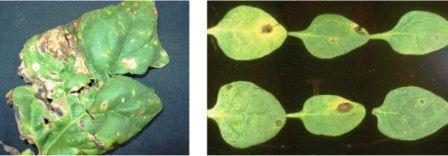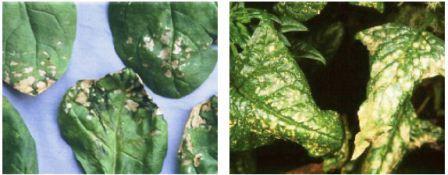Spinach: Diseases and Symptoms
Spinach: Diseases and Symptoms
Downy mildew
Disease symptoms- The initial stage: Dull to bright yellow spots that form on cotyledons and leaves of all ages.
- The late stage: Enlarged spots and become browning and dry. Close inspection of the underside of the leaf often reveals the purple growth of the fungus.
- If disease development is extensive, leaves appear curled and distorted and may take on a blighted effect as a result of numerous infection sites.
Host range: Spinach, Chenopodium weed, Beta sp.

- Fungus survives in disease plant debris or in soil in form of resting spore.
- Primary: The heavy canopy of densely planted spinach retains much moisture and creates ideal conditions for infection and disease development.
- Secondary: Spores (sporangia/zoospores) are dispersed in the air from plant to plant and field to field by winds and splashing water.
- Heavy canopy of densely plantations, relative humidity > 90%, high soil moisture and frequent rains favour the development of diseases.
Anthracnose
Disease symptoms- In initial stage: Small, circular, water - soaked lesions on both young and old leaves.
- In late stage: Lesion turns brown to brownish in color, and become thin and papery.
- Tiny black fruiting bodies (acervuli) form profusely in diseased tissue and are a characteristic feature of the disease.
Host range: Cowpea (Vigna unguiculata), bean (Phaseolus vulgaris) and betel vine (Piper sp)

- Fungus survives in plant debris or soil.
- Primary: Seed borne inoculum and dormant mycelium in infected plant debris.
- Secondary: Spores are spread from plant – to - plants by splashing water from rains or sprinklers
- Relative humidity > 90%, High soil moisture and frequent rains favour the development of disease.
Cladosporium Leaf spot
Disease symptoms- Round, brownish leaf spots that rarely exceed 0.2 inch in diameter.
- Dark green spores and mycelium later develop in the centers of the spots.
- The presence of dark green sporulation distinguishes Cladosporium leaf spot from anthracnose and Stemphylium leaf spot diseases, both of which also form circular lesions.
Leaves showing disease symptoms

- Pathogen survives in seeds and these seeds are source of primary inoculums. The secondary spread occurs by means of conidia.
- Heavy rain in spring favours the development of diseases.
Stemphylium leaf spot
Disease symptoms Initial stage: Small (0.1 to 0.2 inch diameter), circular to oval, gray-green leaf spots.
Initial stage: Small (0.1 to 0.2 inch diameter), circular to oval, gray-green leaf spots.- Late stage: Leaf spots enlarge, remain circular to oval in shape, and turn brownish in color. Older spots coalesce, dry up, and become papery in texture. Leaves showing disease symptoms
- Visual signs of fungal growth are generally absent from the spots; hence this symptoms is readily differentiated from foliar diseases in which purple growth (downy mildew), green spores ( Cladosporium leaf spot), or acervuli (anthracnose) develop within circular lesions.
- Overall, symptoms resemble the brownish, circular spots caused by pesticide or fertilizer toxicity.
- Fungus survives in seeds and infected seeds are the source of primary inoculums. Secondary infection occurs by means of conidia.
- High humidity and moisture conditions favour the development of disease.
Damping off and root rot
Disease symptoms- Symptoms of damping-off and root rot consist of poor seed germination, pre-emergence death of seedlings, post emergence death of newly emerged seedlings, stunted plants, yellowed lower leaves, general poor growth, wilting, and eventual collapse and death of older plants.
- Roots of infected plants can appear water-soaked or brown to black in color. The upper taproot may be girdled by a necrotic lesion, or the tip of the taproot may be necrotic. In severe cases, nearly all roots may be girdled or rotted off.
- Severity is influenced by cultivar, soil texture, irrigation, and pathogen populations. Severe damping- off is associated with clay or poorly draining soils with a history of frequent spinach production. While all stages of spinach can be infected by root rot organisms, newly emerging plants and young seedlings are very susceptible.
- The fungus survives in soil and inoculum present in the soil is source of primary infection. Secondary infection occurs by means of conidia through rain splash or wind.
- High humidity, high soil moisture, cloudiness and low temperatures below 24°C for few days are ideal for infection and development of disease.
- Crowded seedlings, dampness due to high rainfall, poor drainage and excess of soil solutes hamper plant growth and increase the pathogenic damping-off.
IPM for Spinach
To know the IPM practices for Spinach, click here.
Source: NIPHM, and Directorate of Plant Protection, Quarantine & Storage
Last Modified : 12/10/2019
© C–DAC.All content appearing on the vikaspedia portal is through collaborative effort of vikaspedia and its partners.We encourage you to use and share the content in a respectful and fair manner. Please leave all source links intact and adhere to applicable copyright and intellectual property guidelines and laws.
RELATED ITEMS
Fenugreek Diseases
This topic covers information about Fenugreek Dis...
Cabbage and Cauliflower diseases
This topic covers information about Cabbage and Ca...
Onion: Diseases and Symptoms
This topic covers the Information related to Disea...
Broccoli Diseases
This topic covers information about Broccoli Descr...
